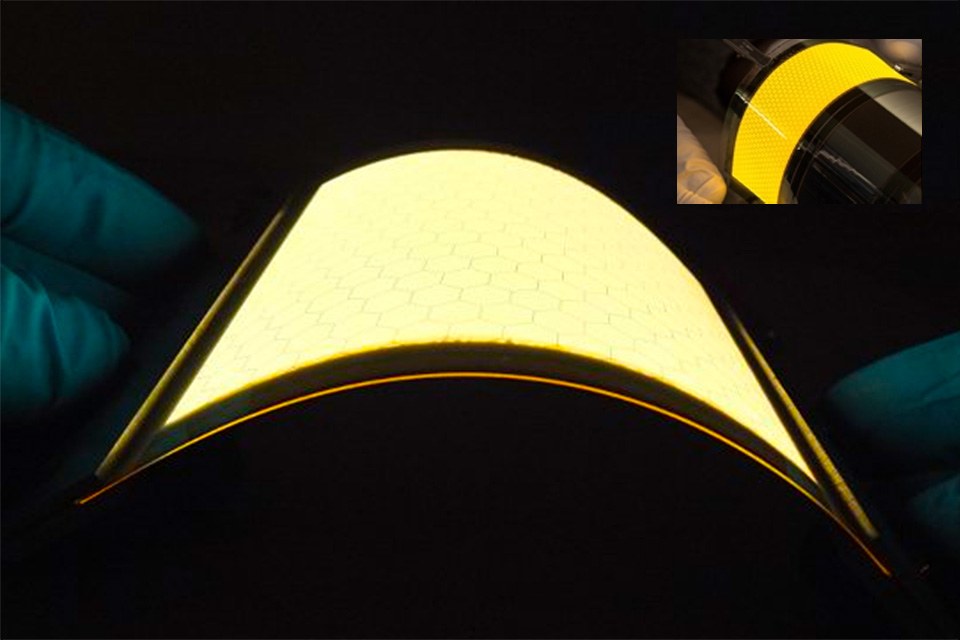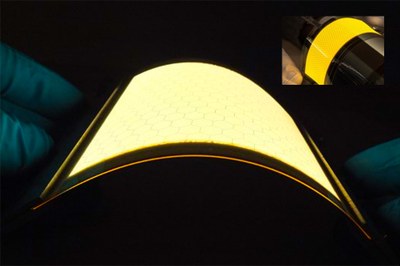Holst Centre and Flex-o-Fab Take the First Step Towards "Lighting by the Mile"
Researchers from the EU-funded Flex-o-Fab project have successfully fabricated working OLED devices on a flexible barrier layer produced in a roll-to-roll (R2R) process. Produced on a PET plastic film, this breakthrough is a significant first step towards taking flexible OLEDs ‘from lab to fab’ and hence to commercial production. It draws on technical developments achieved within both Flex-o-Fab and Holst Centre’s joint research program into high-performance flexible barriers for organic electronics.
OLEDs – or organic light-emitting diodes – hold the promise of flexible, thin, lightweight and power-efficient lighting applications including wearables. They also have the potential to be manufactured in high-volume R2R processes, allowing “lighting by the mile” and greatly reducing productions costs.
However, the materials from which these exciting devices are made are very susceptible to environmental factors and need to be protected from air and moisture. For flexible devices, the conventional approach of producing OLEDs on glass isn’t suitable. Holst Centre and its eco-system partners have been at the forefront of developing a flexible, thin-film barrier layer for use with plastic foils, and were the first to produce a high-performance barrier foil in a R2R set-up.
Now, by performing in-situ planarization of the film immediately before depositing the barrier, Holst Centre researchers have been able to deliver R2R barriers that perform similar to barriers produced in sheet-to-sheet (S2S) processes, thereby enabling potential cost savings in volume production. “We have successfully produced over 2.5 kilometers of R2R barrier film based on a single inorganic layer with water vapor transmission rates (WVTR) lower than 10-5 g/m2 per day on commercial-grade PET foil,” said Sandeep Unnikrishnan, Roll-to-Roll Barrier project leader at Holst Centre.
The Holst Centre-led Flex-o-Fab project has used that foil to create working OLED devices. To do this, researchers temporarily laminated the barrier foil to a glass substrate before depositing the OLED and then debonding the finished devices. All the OLED devices produced using this roll-to-sheet (R2S) process worked, delivering performance comparable with devices fabricated on S2S barrier foils and with rigid OLEDs on glass.
Conventional equipment was used throughout the process. The devices were produced on a PET film from DuPont Teijin Films, using a debonding adhesive from Henkel for the R2S lamination. Different processing steps were carried out at different partner locations – TNO/Holst Centre (Netherlands), Philips GmbH (Germany) and the École Polytechnique Fédérale de Lausanne (Switzerland).
“Roll-to-roll production will be essential to bringing flexible OLEDs to market at an affordable price. By demonstrating the first OLEDs on a high-performance, R2R-produced flexible barrier foil, we have taken a major step towards commercial production. This success shows the power of industrial collaboration, and draws on the combined expertise of a pan-European program and a global open-innovation platform hosted by Holst Centre,” said Flex-o-Fab project manager Date Moet of Holst Centre.
About Flex-o-Fab:
The Flex-o-Fab project aims to help bring flexible OLEDs to market by 2018. It brings together companies and institutes with strong backgrounds in organic electronics from across Europe. Current project members are:
• Holst Centre / TNO (Project coordinator) [Netherlands]
• Philips Research [Netherlands, Germany]
• Philips GmbH [Germany]
• Orbotech Ltd. [Israel]
• École Polytechnique Fédérale de Lausanne (EPFL) [Switzerland]
• Henkel Electronics Materials N.V. [Belgium]
• SPGPrints B.V. [Netherlands]
• Epigem Ltd. [UK]
• Tampere University of Technology (TUT) [Finland]
• Roth & Rau AG Business Unit MicroSystems [Germany]
• Dupont Teijin Films UK Ltd (DTF) [UK]
• CSEM [Switzerland]
Funded through the Factories of the Future Public Private Partnership launched under the European Union’s Seventh Framework Programme (FP7), the Flex-o-Fab project will run for 36 months beginning October 1, 2012. More information and latest developments are available at http://www.flexofab.eu/.


